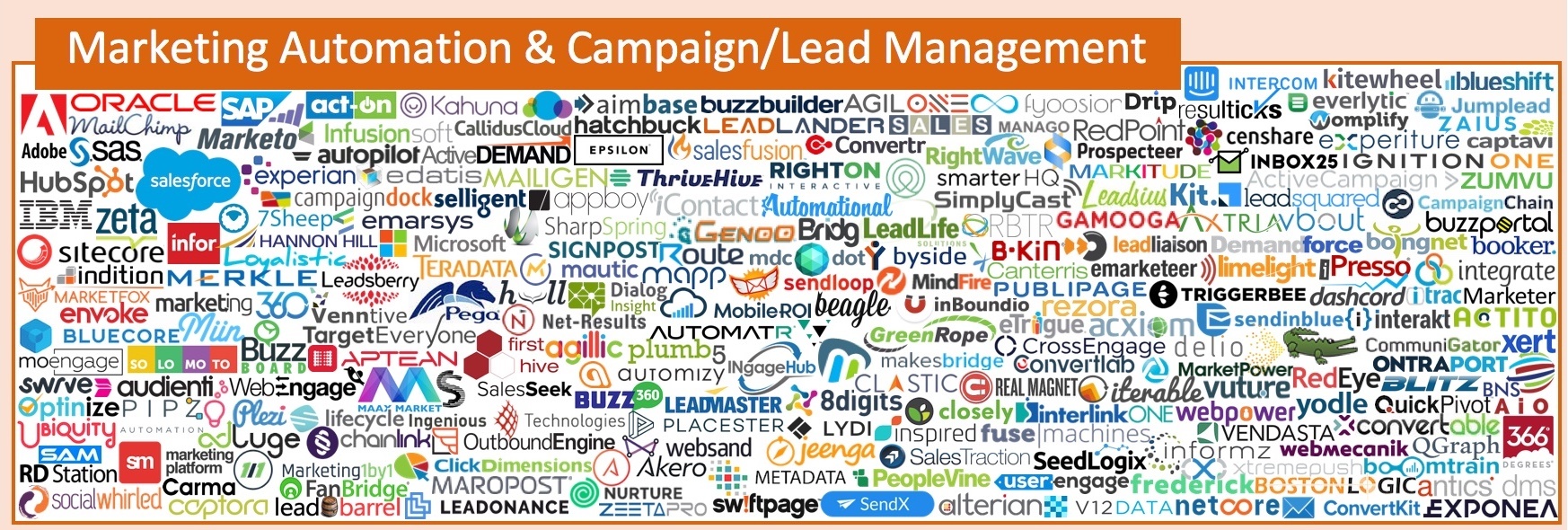If you are choosing a marketing automation system, you may be familiar with the graph below. It is a picture of the nearly 300 systems available on the market today:

And the number of systems is growing rapidly every year. But when you read the blogs of some of the largest system providers, it's easy to think that their systems are unique or that they invented the category of marketing automation itself.
In fact, all the popular systems (e.g. Hubspot, Pardot, Marketo) are copying each other. We now have a landscape of systems that all do pretty much the same thing.
Features when choosing a marketing automation system
Since all systems copy each other, today almost all popular systems have the following features:
- Inbound(landing pages, email tracking, tracking)
- Sync capabilities (sync with event tools, chat tools and CRM)
- Good email editor (with drag-and-drop capabilities so you can create your own designs).
- Tracking and contact history (so you can see exactly what your contacts have done)
- Qualification (scoring)
- Automations (create campaigns in flowcharts with events and branches)
- Built-in CRM that is easy to use and customize
How the choice of marketing automation goes wrong
Due to the fact that all popular systems do similar things, it is usually not the wrong choice of system that leads to failure.
I've even seen companies switch from Hubspot to Pardot and vice versa in the belief that it will be easier to use. But since both have roughly the same features and work in a similar way, the switch doesn't matter.
For most companies, it is not the lack of features that is the problem. It's the complexity. And by taking new features from each other all the time, they become more complex every year. Especially the larger systems that have now reached a point where they have to go after the enterprise market to maintain profitability (a very common phenomenon in many industries).
A marketing automation system is basically a bunch of features bundled together behind a screen. You can achieve exactly the same thing by using various free tools and building the castle yourself.
 The advantage of having everything in one system is of course that everything is integrated and works together more smoothly. And data is shared between different components. But basically, a marketing automation system is a big Lego box. A lot of pieces that you have to put together yourself.
The advantage of having everything in one system is of course that everything is integrated and works together more smoothly. And data is shared between different components. But basically, a marketing automation system is a big Lego box. A lot of pieces that you have to put together yourself.
And the more Lego pieces, the harder it is to build Lego.
It simply takes time to implement everything and make it work together smoothly.
So what should you consider when choosing a marketing automation system?
Precisely because of the complexity, and because all systems are similar, the choice of system itself becomes secondary. Instead, the support provider you choose to work with becomes all the more important.
And when choosing a supplier, you should look out for three warning signs:
- If the supplier tries to tie you down to long-term contracts
- If they charge high start-up fees, training fees, workshop fees or high fees to implement (this just shows that the system is complex).
- And whether their business model really gives them an incentive to continue helping you after the end of the commitment period.
A business model that relies on the vendor (or, in many cases, the agency selling the system locally) getting big money up front and having long lock-in periods shows that they do not expect a long-term relationship.
Instead, choose an agency or system provider that has no lock-in periods, low initial fees, and where they make money only if you stay with them in the long run. In the end, both you and that provider will benefit more.
Would you like to try being promoted to?

Want to see how it feels to be marketed to with a Marketing Automation system? Try our automated flow with one email a week for 5 weeks where each email with videos, screenshots and fun exercises shows how the system reacts interactively to your actions.

